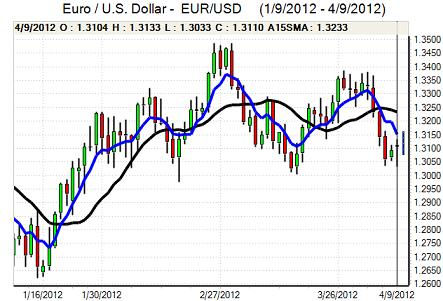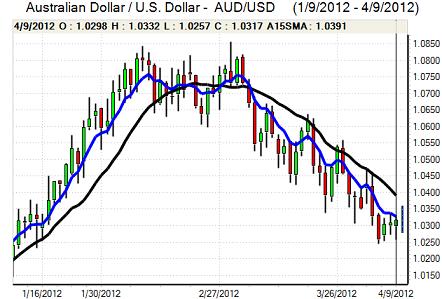EUR/USD
After extremely quiet Friday trading conditions ahead of the US employment report with European markets on holiday, activity spiked following the release. The headline payroll increase was significantly weaker than expected with an increase of 120,000 compared with expectations of an increase above 200,000 and a revised 240,000 gain for the previous month. This was the lowest reading for four months which re-ignited doubts surrounding the US trends.
There was a significant impact from seasonal factors as employment numbers were boosted during the first quarter from favourable weather conditions. The expected increase in jobs at the beginning of the second quarter was, therefore, lower than usual. This was illustrated by the reported decline in retail and construction jobs for the month. The unemployment rate declined to 8.2% from 8.3% previously, but this reflected a decline in labour-market participation rates.
There was fresh uncertainty surrounding the outlook for monetary policy with some renewed speculation that the Fed could sanction additional quantitative easing. There were no substantive comments from Fed officials.
The Euro gained ground following the data as the US currency was subjected to underlying selling pressure, although the currency was still unable to make much headway. The Euro was hampered by further structural fears with continued speculation that the difficulties in Spain would intensify. There was a further widening in yield spreads and a deterioration in confidence surrounding the banking sector.
There was a small decline in Euro short positions according to the latest speculative positioning data and the bias remains for Euro puts which will lessen the potential for Euro short covering. The Euro remained broadly resilient in subdued trading conditions on Monday, but was unable to move above the 1.3150 area.

Source: VantagePoint Intermarket Analysis Software
Call now and you will be provided with FREE recent forecasts
that are up to 86% accurate* 800-732-5407
If you would rather have the recent forecasts sent to you, please go here
Yen
The dollar dipped sharply against the yen following Friday’s payroll data with a dip to test support below 81.50 from a high around 82.50 ahead of the release while the Euro also remained generally on the defensive.
Dollar yield support remained weaker which kept he currency on the defensive and risk appetite was also generally fragile as equity markets were subjected to selling pressure. There were concerns surrounding the regional growth outlook which also curbed yen selling pressure.
The dollar advanced slightly following the reported Chinese trade surplus. The Bank of Japan held monetary policy steady at the latest policy meeting. There was still some speculation that the central bank would act to relax policy again late in April which curbed yen buying with dollar support in the 81.30 area.
Sterling
Sterling was able to gain ground against the dollar following the latest US employment data and able to resist a renewed test of support in the 1.58 region. There were gains to the 1.59 area on Monday as the Sterling tested support levels near 0.8225 against the Euro. Liquidity was inevitably extremely low as UK and most European markets remained on holiday.
The latest NIESR data suggested that there was GDP growth of 0.1% for the first quarter. This would mean that the UK had escaped a technical recession, but this was a much lower estimate than that derived from recent PMI data. Any figure near 0.1% would be a serious setback for the economy and Sterling. The latest RICS house-price index recorded a reading of -10% for April from -13% previously and this was the best reading since mid 2010 and helped Sterling test resistance above 1.59 even though it still indicated that prices were generally falling.
Swiss franc
The dollar was unable to hold above 0.92 against the Swiss currency and retreated to lows near 0.9150, although ranges were relatively narrow. Principal attention again focussed on the crosses as the Euro was unable to pull significantly away from the 1.20 minimum level. Indeed, the cross briefly dipped to just below this level in Asia on Monday.
The price action continues to suggest that the National Bank is intervening to prevent the Euro weakening below the minimum level. There will be further concerns that Euro structural fears will trigger further defensive flows into the Swiss currency with official policy under very close scrutiny.

Source: VantagePoint Intermarket Analysis Software
Call now and you will be provided with FREE recent forecasts
that are up to 86% accurate* 800-732-5407
If you would rather have the recent forecasts sent to you, please go here
Australian dollar
The Australian dollar was subjected to erratic trading following Friday’s US payroll release with selling pressure above the 1.03 level. There was renewed selling pressure in Asian trading on Monday following the higher than expected Chinese inflation data before the currency regained the 1.03 level.
There will be further concerns surrounding the regional economy and the Australian dollar will also be vulnerable on expectations of a Reserve Bank interest rate cut in May. The domestic data remained subdued with the construction PMI index again below the 40 level, although the impact was limited. The Australian dollar was unable to hold a move towards 1.0350 with some disappointment over the level of Chinese imports in the latest data as sentiment remained fragile.



